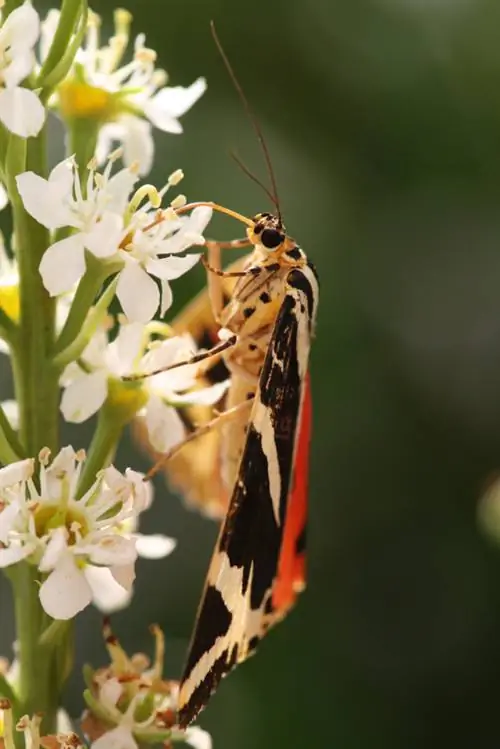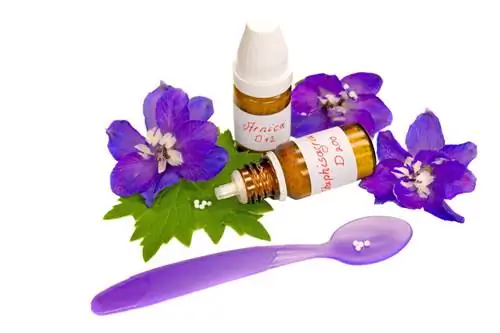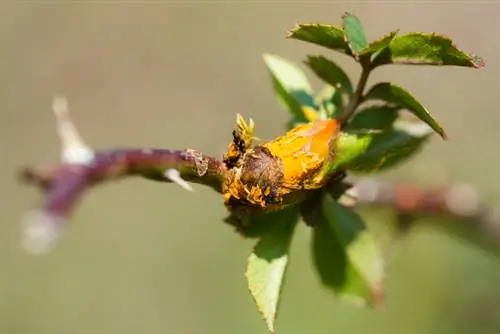- Author admin [email protected].
- Public 2023-12-16 16:46.
- Last modified 2025-01-23 11:20.
Cherry laurel is actually one of the most robust hedge plants. It thrives well even in the shade and in less than optimal locations and is less susceptible to disease. If you have discovered changes in the leaves that indicate disease in the laurel cherry, you can use our tips to identify many of the damaging symptoms yourself and combat them successfully.

What diseases can occur with cherry laurel and how can they be treated?
Cherry laurel can be affected by various diseases, including gunshot, powdery mildew, downy mildew and leaf edge necrosis. To treat affected plants, it is important to remove diseased leaves and plant parts, optimize the location and, if necessary, use suitable fungicides.
The most common diseases affecting the laurel cherry are:
- Shotshot
- Powdery and downy mildew
- Leaf edge necrosis
You can recognize these by the discolored, stunted leaves or unsightly coatings on the top or bottom of the leaves.
The shotgun disease
This fungal disease occurs not only on the laurel cherry, but also on the foliage and fruits of plum, peach or cherry trees. The fungus “Stigmina carpophila” is responsible for the infection. To date, there are no cherry laurel varieties that are completely resistant to this disease.
malicious image
The freshly sprouted foliage of the laurel cherry initially shows reddish-brown spots about five to ten millimeters in size on the upper side of the leaf. As the plant rejects the damaged tissue, the holes that are typical of this plant disease appear in the leaves. If the infestation is severe, the cherry laurel drops the infected leaves. Shotgun blast occurs primarily in wet years and in foggy areas with high humidity.
Cause
The fungus overwinters in the diseased branches as well as in the foliage and infected fruits of infected plants. The fungus develops its mycelium in the wounds of the branches, in which the spores form. The spores spread further through winds or rain showers.
Combat
Remove diseased and fallen leaves and dispose of all plant parts in the household waste so that the fungus cannot spread further the following year. Cut back the cherry laurel before the next shoots and thin out the bushes so that the wind can blow through the leaves.
You can treat shotgun with suitable fungicides. The agents kill the fungal spores before they attack the plant. That's why you have to spray the laurel cherry before it first sprouts and repeat the application once or twice.
Prevention
Some cherry laurel species are more tolerant and resistant to the fungal disease. Plant only such varieties in moist, foggy regions. Wind-open and sunny locations are ideal, where the laurel cherry can dry quickly after rain showers.
Powdery and downy mildew
Dangerous symptoms of powdery mildew
Powdery mildew forms wipeable white to dirty brown deposits on the top and bottom of the leaves, the young shoots, flowers and fruits of the laurel cherry. As a result, the leaves brown and die. In contrast to other fungal diseases, the mycelium of powdery mildew does not grow in plant tissue, but thrives on the leaf surface. Only the sucking processes (haustoria) anchor themselves in the leaves and remove nutrients from the cherry laurel. Since powdery mildew is an obligate parasite that relies on the survival of the host plant, even heavily infested shrubs can continue to live for a long time.
Cause
Powdery mildew is a dry fungus and occurs more frequently on warm days in spring and autumn, when dew forms at night. In autumn, the fungus forms dark, spherical winter fruiting bodies that overwinter in the fallen leaves of the laurel cherry.
Downy mildew damage
The spores of downy mildew penetrate the cherry laurel and grow inside the leaves. From here, the spore carriers reach the underside of the leaf through stomata, where they appear as a typical gray-whitish coating. Brown or yellow discolored areas become visible on the upper side of the leaf. The affected bushes are severely weakened and can die.
Cause
In contrast to powdery mildew, downy mildew loves moist weather conditions. One-sided fertilization and poor air circulation promote the infestation.
Combating powdery mildew and downy mildew
Cut off affected leaves immediately and dispose of them with household waste. Do not compost the diseased plant parts, as the mildew survives in the soil and infects other plants when the fertilizer is applied. For light infestations, spraying with milk, field horsetail, garlic or tansy can help control the mildew. If this is not enough, you can get highly effective fungicides commercially.
Prevention
An airy location, good light, morning watering and moderate fertilization reduce the susceptibility of the cherry laurel to this fungal disease. Preventive spraying with field horsetail ensures that the laurel cherry is strengthened.
Leaf necrosis
malicious image
The edges of the older leaves turn brown. The leaf gradually dries up and eventually falls off. Severe infestation can lead to almost complete loss of leaves.
Cause
In addition to environmental pollutants, the occurrence of this disease in cherry laurel is directly related to water quality. If the sodium content is too high, this leaf damage often occurs.
Combat
Use only rainwater for watering.
Prevention
Unfortunately not possible as the groundwater and air quality cannot be influenced.
Tips & Tricks
If you discover small dark green or reddish-brown dots on the underside of the leaf on the side of the leaf axils, it is often not a disease at all. These nectar glands (nectarines) release cell sap containing a lot of sugar, which attracts insects.






